| The
Untold Story of Kanbun Uechi Pre-publication Interview |
|
(December
23rd 2016) The Pangai-noon Kenpo Academy sponsored a discussion at the Shubukan Dojo to celebrate publication of the English version of The Untold Story of Kanbun Uechi. Participants included the author, Keisuke Fujimoto, project manager, Hitoshi Sumida, and main translator, Robert Garone (Tokyo Bayside). The event lasted about an hour and also touched upon a number of topics not covered in the book. The Untold Story of Kanbun Uechi describes the life, times, and personality of Kanbun Uechi, as well as the origins and history of Uechi-ryu. Please
send any questions or comments related to the English publication
via email to this site. |
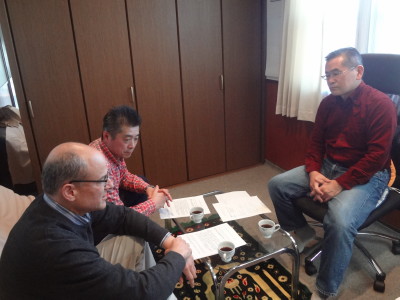
(Directorfs office of the Shonan Shubukan Dojo) |
| (Fujimoto) There has been a lot of interest in translating The Untold Story of Kanbun Uechi since it was published in Japanese 2 years ago. After almost a full year of planning, we have finally completed the English version. I would like to thank you and all members of the project team for your efforts. Prior to publication of the English version, I thought it would be a good idea to share with future readers a short preview of what to expect as well as some previously undisclosed stories uncovered during the research process. I hope all of them will enjoy the book! My first question for both of you is what kind of impression did you get of Master Kanbun when working on the translation? (Robert) Before getting involved in the project, I had always thought of Master Kanbun as an easy going person who was an exceptionally strong martial artist, but when I learned about how he left behind his home and family in Okinawa once for China and then again later in life for Wakayama, I said to myself now there is a person with a strong belief in himself. It really took a lot of courage to do that. (Sumida)
I think you can say Master Kanbun was more of a humble man rather
than someone loaded with charisma. When he decided there was something
important to do, he pursued it whole-heartedly with little regard
for what others had to say. I never had the impression he boasted
about his martial arts abilities, forced his skills on anyone,
or even really aspired to being someone elsefs teacher. |
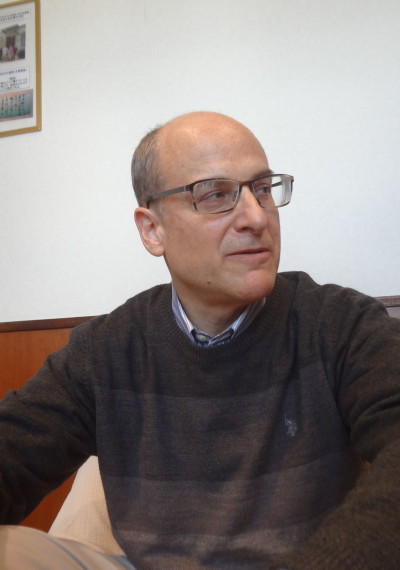
Mr.Robert Garone |
(Robert)
Was there ever a time over the five years spent researching and writing
the book you thought about giving up?
(Fujimoto) The research certainly involved a lot of effort and quite a bit of my personal resources, but I never thought about quitting. On the contrary, I was amazed at the way in which I would meet just the right people when searching for information, and I often had a strange feeling that Masters Kanbun and Kanei really wanted me to tell their story.One of Kanbunfs students living in Iejima was fond of saying, gYou were born to write Kanbunfs biography, so get to work on it!h |
|
Probably the biggest challenge I faced was reconciling and writing
about all of the differences in Uechi-ryu that I encountered, especially
when considering the Okinawan Uechi-ryu we practice, the techniques
demonstrated by descendants of Shushiwa in Fujian Province, and
the techniques used at the Uechi-ryu Tomoyori Dojo in Wakayama.
I knew I would have to explain these carefully in the book. (Fujimoto) Did any of the episodes from Kanbun senseifs life leave a particularly strong impression? (Robert) I was really surprised by the story at the Shinbori Bridge,- the one where Kanbun-sensei jumps onto the rail, gets into a sanchin stance, and challenges his students to try to knock him into the river below. It was certainly not something I was expecting out of a karate mater, and I can only imagine how strong his sanchin stance must have been. (Sumida) Kanbun-sensei didnft take alcohol often, but I enjoyed the story about how he would sometimes have a few drinks with his students and start to sing Chinese songs. They would then close the windows and he would do Sanseiryu kata. I felt this showed the somewhat mischievous part of his personality and thought it gave a great sense of the man he really was. (Robert) How do you think Kanbun-sensei would react if he were to learn that Uechi-ryu has become popular all around the world? (Fujimoto)
Kanbun-sensei was a very careful person and was slow to accept
new students unless they had an introduction, and he also treated
Sanseiryu kata as a family treasure which he taught solely to
his son Kanei. In light of this, I can only imagine half of him
would have happily approved of the stylefs current popularity,
while the other half would be conflicted by some difficult feelings.
Of course, there is a big difference in the world we live in today
and the environment surrounding martial arts in Kanbunfs time. |
| (Fujimoto)
When he was teaching
in Wakayama, karate masters like Gichen Funakoshi, Chojun Miyagi,
and Choki Motobu were teaching and making plans for the future
of their styles in Tokyo, but Kanbun sensei never joined these
gathering. The most he would do was travel to meet his own students
in Osaka. The rail system was well developed at the time, so if
he wanted to go to Tokyo and get involved, it was definitely possible.
You can see from this that Kanbunfs intent was not to teach his
own style to as many people as possible, but to make sure his
own students were developing in the right way. |
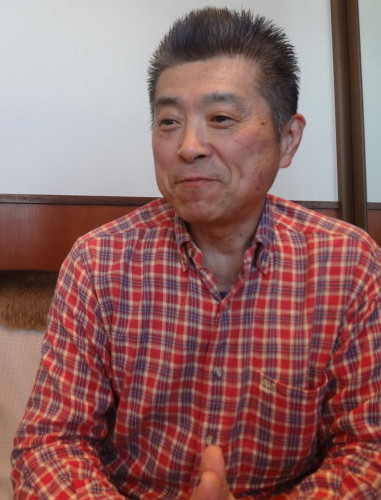 Mr.Sumida Hitoshi |
| (Fujimoto)
What would you say to Kanbun sensei if he were still alive today?
(Robert) I started doing Uechi-ryu after turning 50, but was initially drawn to the style by the conditioning and body hardening thatfs involved. I would really like to ask what he thinks is the best way for an older guy like me to go about doing this. (Fujimoto) I would like to ask him the same thing (laugh). Ifm sure he had students of all ages when he was in Wakayama and Iejima. (Sumida) My interest is in finding out more about Shushiwa: what kind of person he was and exactly what it was that he taught Master Kanbun. Ifve often wondered about the kind of training they did and just what techniques were used. (Fujimoto) Kanbun sensei began training in China right around 1900 at the time of the Boxer Rebellion. Anti-foreign sentiment was at an extreme and if you look at pictures from that time, you can actually see the young boxers marching about town with swords strapped on their backs. The Chinese Kenpo studied in those days had to have been a lot different from what we are doing in the peaceful times we know today. We were told in Fuzhou that Shushiwa actually died from a wound sustained in a fight with one of the gdojo bustersh. (Sumida)
How do you think Kanbun sensei would react if he were to see the
Uechi-ryu techniques we now practice? His son Kanei did a lot
of research into and made a number of changes to the style. |
| (Fujimoto)
I imagine he would likely be a little disappointed. The reason for
this is that he probably thought he had perfected the karate he
taught in Wakayama and Iejima (Sanchin, kotei kitae, kata, sparring).
The research I did revealed a number of sources attesting that visitors
to the Wakayama Dojo (the Academy), including people from other
karate styles, were consistently impressed by the strength of Kanbunfs
techniques. |
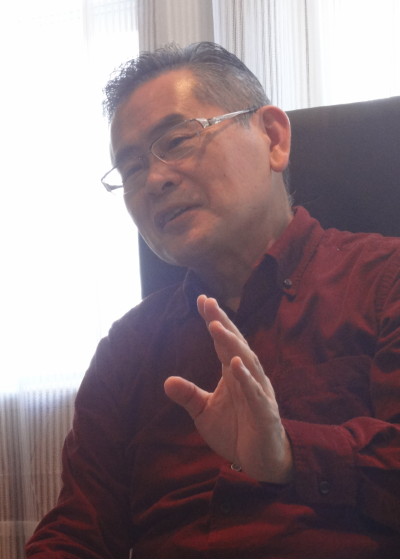 Mr.Keisuke Fujimoto |
| I
think he would be most surprised by the circle block (mawashi uke)
that is currently used in Uechi-ryu. Kanbun sensei did not teach
a circle block and would instead use an inside-out parry (kake uke)
for mid-section attacks and an upper block (hajiki uke) to defend
against attacks to the head. I personally believe he would question
why a circular motion should be used to protect against a strike
to the face. Kanbun's students I talked to iejima who were with
him in Wakayama sometimes said, "It may be that times have
changed, but a lot of the karate used today doesn't seem to have
much practical application." Of course, I recognize that the
techniques of modern Uechi-ryu developed as a result of improvements
made by our own teachers and am in no way demeaning their value.
(Sumida) The kenpo style popular when Kanbun sensei was in China took shape at a time when there were no rules or judges. Itfs only natural there are major differences with the karate we use today. Of course therefs little point in taking up the argument that the old techniques are better or worse than the new ones. (Fujimoto) Were there any parts of the book you thought could have been researched more thoroughly? (Robert) After Kanbun sensei left China, he spent more than 10 years in Okinawa before leaving for Wakayama. I would have liked to know a few more details about his life at that time. (Sumida) Yes, I agree. The only thing Ifve heard is that he lived in the country and made money by cutting down trees and selling the wood. This period is one of the real blank spaces in Kanbun senseifs life story. (Fujimoto)
There are very few karate-related stories from this time in Kanbun
senseifs life. He left China and gave up training under the special
set of circumstances described in the book and then spent most
of his days in Okinawa working quietly to support his family.
His final years in China were not good ones, and I believe he
really didnft want to remember or talk about them with anyone.
|
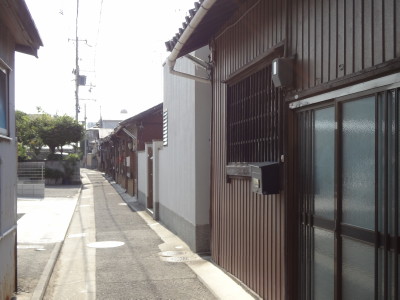
Tebira,Wakayama-the site of Kanbun's first dojo |
| (Sumida)
Even so, you did write he taught kenpo to a few junior high school
students living in the area.
(Fujimoto) Yes - there are records that show he did just that, but what has come to light more recently is that it wasnft hard core martial arts he was teaching. Rather, he would demonstrate some basic techniques and supplement this with instruction in morals and behavior. This seems very much in character for someone who liked children as much as Kanbun sensei. (Sumida) Both Kanbun sensei and Kanei sensei had contact with Kenwa Mabuni, the founder of Shito-ryu, and we would probably uncover some interesting anecdotes if the Shito-ryu people were to carry out more detailed research on Mabuni. (Robert) Fujimoto-sensei, are you considering any additional research into the life of Kanbun Uechi, or perhaps publishing future chapters or other additions to your work? (Fujimoto) I believe my research into Kanbun senseifs life has been exhaustive and currently do not have plans to do any more. The only thing I will add is that shortly after publishing the Japanese edition of the book, I had the chance to meet with Kanbun senseifs only female student and she passed on some fascinating information. This included accounts of his training in China and life with his teacher during that time, and one truly surprising discovery was that Kanbun sensei interrupted his training in China more than once to return to Okinawa. I am now in the process of preparing a revised version of the Japanese edition and am planning to discuss with the translation team whether we should consider putting this out in English as well. (Fujimoto) Is there anything you can think of to encourage people practicing Uechi-ryu all over the world to learn more about Kanbun senseifs life and the history of Uechi-ryu? (Robert) There are old versions of some of the kata such as Seisan. I always thought it might stimulate interest in the history of Uechi-ryu if people had the opportunity to study the different versions of the kata. Just witnessing a demonstration of the Seisan done in Wakayama certainly sparked my interest. (Fujimoto) The techniques of Uechi-ryu have changed with time as the style moved from Wakayama to Osaka, and then to Amagasaki and finally Okinawa. It might be a worthwhile challenge to study these differences together with the history that made them. Rather than emphasizing whatfs right or wrong, old or new, any such attempt would have to be done in a spirit of cooperation and mutual respect for all people involved. A large number of Uechi-ryu practitioners in Okinawa and from overseas have already been visiting Wakayama to do just this. |
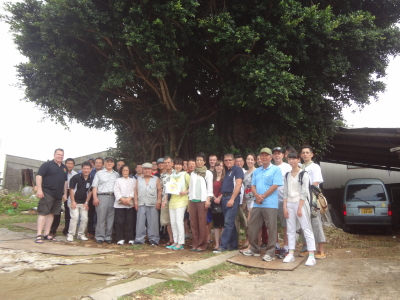 Ie island where Kanbun Uechi sensei opend his last dojo. |
(Sumida) It would be great if publication of the English version of your book leads to more views, questions, and discussion in this area, especially from people overseas. (Fujimoto) When I was in Fuzhou doing research with the local martial arts association, I tried to do as much as possible to investigate Shushiwa sensei and collect information on origins of the style, but I sometimes thought someone overseas might know a different approach to shedding light on Kanbunfs life story. What has always been most important to me as a martial artist is to faithfully pass on the techniques, spirit, and history left by those who came before us. From this perspective, I sincerely hope to build stronger relationships with Uechi-ryu people living overseas. I fully believe that what is most important for any style is to keep on growing into the future, but to do so with a firm grasp of your origins and where you are now. (Robert) On a different topic, one of the things I found really interesting in the book was the detailed historical and cultural context, such as the description of the street lined with playhouses and cinemas in Wakayama which Kanbun sensei sometimes visited. (Sumida)
Yes, it shows that Kanbun sensei was something of a romantic (laugh).
I really enjoyed those little glimpses into his personality that
are not well known but provide a sense for the kind of person he
actually was. (Fujimoto) Yes - one of his students from Wakayama said they did Sanchin, kotei kitae, Seisan, sparring, and basic conditioning, and he also told me about Kanbun senseifs favorite sparring techniques. Most of the time Kanbun sensei had an easy going disposition, but when practice started, his expression would become almost fearful and nobody wanted to go near him. On the other hand, if someone could not pay the entire monthly fee for lessons, he was generous enough to let that student participate in class, and the dojo was said to have been very popular. (Sumida) Do you have plans to launch any big Uechi-ryu events in the future? (Fujimoto) In 2025, 100 years will have passed since Kanbun sensei started to teach in Wakayama. I would really like to hold a special commemorative event with Wakayama, Okinawa, and Tokyo as that date approaches. Itfs still some years away, but Ifm looking forward to it and hope Ifll be able to continue training so that I myself can participate. I also hope many people from overseas will be able to join. Well that about wraps things up. Ifd like to thank both of you for sharing your time during this very busy season of the year. |
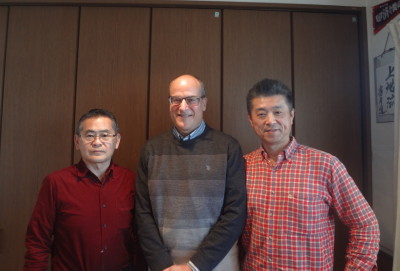
Group photo |
| Copyright(C) 2002-2017 Okinawa Uechi-Ryu Karate-Do Association All Rights Reserved. |